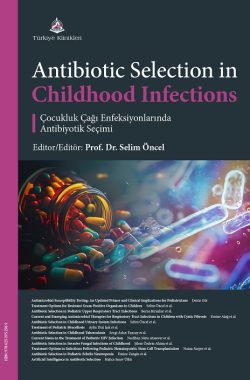Antimicrobial Susceptibility Testing: An Updated Primer and Clinical Implications for Pediatricians
Deniz GÜRa
aHacettepe University Faculty of Medicine, Department of Medical Microbiology, Retired Faculty Member, Ankara, Türkiye
Gür D. Antimicrobial susceptibility testing: An updated primer and clinical implications for pediatricians. Öncel S, ed. Antibiotic Selection in Childhood Infections. 1st ed. Ankara: Türkiye Klinikleri; 2024. p.1-6.
ABSTRACT
Antimicrobial susceptibility tests (AST) guide the clinicians for choosing the optimal therapy. There are many conventional phenotypic methods that can be used routinely to determine antibiotic susceptibility and among these, the ”microbroth dilution test” is considered the gold standard. Quantitative tests which give minimum inhibitory concentration (MIC) of the antibiotic should be preferred in serious infections. Antibiotic susceptibility test results do not always guarantee success in therapy and results should always be analyzed with pharmacokinetic (PK) parameters. Conventional phenotypic antibiotic susceptibility test procedures and interpretation of test results will be summarized in this review.
Keywords: Microbial sensitivity tests; minimum inhibitory concentration; disk diffusion antimicrobial tests; serum bactericidal test; etest
Kaynak Göster
Referanslar
- EUCAST Disk Diffusion Method for Antimicrobial Susceptibility Testing Version 11.0 (January 2023). [Link]
- Gajic I, Kabic J, Kekic D, Jovicevic M, Milenkovic M, Mitic Culafic D, et al. antimicrobial susceptibility testing: a comprehensive review of currently used methods. Antibiotics (Basel). 2022;11(4):427. [Crossref]
- Salam AM, Al-Amin Y, Pawar JG, Akhter N, Lucy IB. Conventional methods and future trends in antimicrobial susceptibility testing. Saudi Journal of Biological Sciences. 2023;30:1-15. [Crossref]
- The European Committee on Antimicrobial Susceptibility Testing. Breakpoint tables for interpretation of MICs and zone diameters. Version 13.0, 2023. [Link]
- Jorgensen JH, Ferraro MJ. Antimicrobial susceptibility testing: a review of general principles and contemporary practices. Clin Infect Dis. 2009;49:1749-55. [Crossref]
- ISO/FDIS 20776-1: Susceptibility testing of infectious agents and evaluation of performance of antimicrobial susceptibility test devices. Part 1: Broth micro-dilution reference method for testing the in vitro activity of antimicrobial agents against rapidly growing aerobic bacteria involved in infectious diseases. ISO. 2019.
- Kowalska-Krochmal B, Dudek-Wicher R. The Minimum Inhibitory Concentration of Antibiotics: Methods, Interpretation, Clinical Relevance. Pathogens. 2021;10(2):165. [Crossref]
- Riccobono E, Aiezza N, Niccolai C, Giani T, Rossolini GM. Evaluation of VITEK® 2 AST cards (AST-N376 and AST-N397) for susceptibility testing of challenging Gram negatives. Diagn Microbiol Infect Dis. 2023;107:116032. [Crossref]
- Mouton JW, Brown DF, Apfalter P, Cantón R, Giske CG, Ivanova M, et al. The role of pharmacokinetics/pharmacodynamics in setting clinical MIC breakpoints: the EUCAST approach. Clin Microbiol Infect. 2012;18(3):E37-45. [Crossref]
- Turnidge J, Paterson DL. Setting and revising antibacterial suscep-tibility breakpoints. Clin Microbiol Rev. 2007;20(3):391-400. [Crossref]
- Magréault S, Jauréguy F, Carbonnelle E, Zahar JR. When and how to use mic in clinical practice? Antibiotics (Basel). 2022;11(12):1748. [Crossref]
- Oliva L, Scorzolini A, Cipolla MT, Mascellino F, Cancelli D. Castaldi A, et al. In vitro evaluation of different antimicrobial combinations against carbapenemase-producing Klebsiella pneumoniae: the activity of the double-carbapenem regimen is related to meropenem MIC value. J Antimicrob Chemother. 2017;72:1981-4. [Crossref]
- Pierce VM, Mathers AJ. Setting antimicrobial susceptibility testing breakpoints: a primer for pediatric infectious diseases specialists on the clinical and laboratory standards institute approach. J Pediatric Infect Dis Soc. 2022;11(2):73-80. [Crossref]
- Barker CIS, Kipper K, Lonsdale DO, Wright K, Thompson G, Kim M, et al. The Neonatal and Paediatric Pharmacokinetics of Antimicrobials study (NAPPA): investigating amoxicillin, benzylpenicillin, flucloxacillin and piperacillin pharmacokinetics from birth to adolescence. J Antimicrob Chemother. 2023;78(9):2148-61. [Crossref]
- Le J, Bradley JS. Optimizing antibiotic drug therapy in pediatrics: Current state and future needs. J Clin Pharmacol. 2018;58:108-22. [Crossref]
- Ekkelenkamp MB, Díez-Aguilar M, Tunney MM, Elborn JS, Fluit AC, Cantón R. Establishing antimicrobial susceptibility testing methods and clinical breakpoints for inhaled antibiotic therapy. Open Forum Infect Dis. 2022;9(4): ofac082. [Crossref]

